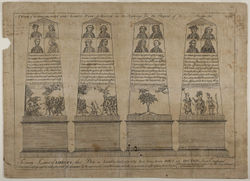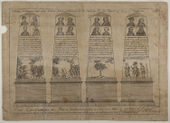Paul Revere
Paul Revere (December 21, 1734–May 10, 1818) was a prominent Boston silversmith, engraver, proto-industrialist, and patriot who played a key role in mobilizing the colonial activism that led to the American Revolution. He designed an obelisk that appeared briefly on Boston Common to celebrate the repeal of the Stamp Act, and is remembered for the “midnight ride” during which he alerted the colonial militia to the approach of British forces on the eve of the battle of Lexington.
History
Paul Revere produced some of the most sophisticated engravings of the Revolutionary era, including political cartoons intended to undermine British rule.[1] A veteran of the French and Indian War (1754–63), Revere later joined the Sons of Liberty, a militant group formed in response to the passing of the 1765 Stamp Act.[2] To mark the Act’s repeal in 1766, Revere designed an “obelisk of liberty” which he erected on Boston Common. Fashioned of translucent paper on a thin frame and illuminated from within by 280 lamps, the obelisk was ornately decorated with symbols, allegories, portraits, and inscriptions representing the triumph of American liberty and its heroic defenders.[3] Following its display on Boston Common the illuminated obelisk was to be removed to the Liberty Tree, a large elm that had become a site for acts of political dissent.[4] Before this could be accomplished, however, the obelisk was destroyed by fireworks launched from its apex in a celebratory pyrotechnical display.[5] Revere had already documented the appearance of the obelisk in a large copperplate engraving [Fig. 1]—now extremely rare)—which depicts the portraits, allegories, and texts that appeared on each of the obelisk’s four sides.[6] The copper plate was subsequently repurposed for the design of a Masonic certificate.[7]
During the build-up to war with Britain in the 1770s, Revere regularly contributed propagandistic engravings to the Royal American Magazine, while simultaneously helping to organize an intelligence system to gather and disseminate information about the movement of British troops.[8] In April 1775 he was instrumental in preventing British capture of rebel leaders and weapons supplies in Concord and Lexington, Massachusetts, by sounding an alarm that called area militias into action. After the American Revolution, Revere became a successful businessman, operating a hardware store, a foundry, and the first rolling copper mill in the United States.[9]
—Robyn Asleson
Texts
- Anonymous, May 19, 1766, Boston Evening-Post (quoted in Brigham 1954: 21)[10]
- “ . . . [T]he Gentlemen Selectmen of Boston, have fix’d upon this Evening for the public Rejoicing, at whose Desire, will be exhibited on the Common, an OBELISK. — A Description of which is engraved by Mr. Paul Revere; and is now selling by Edes & Gill. — The Signal of its Ending will be by firing a Horizontal Wheel on the Top of the Obelisk, when its desired the Assembly would retire.”
- Anonymous, May 26, 1766, Boston Evening-Post, p. 1
- “ . . . On the common the Sons of Liberty erected a magnificent pyramid, illuminated with 280 lamps: The four upper stories of which were ornamented with the figures of their Majesties, and fourteen worthy patriots who have distinguished themselves by their love of Liberty. . .
- “On top of the pyramid was fixed a round box of fireworks horizontally. . . . At eleven o’clock the signal being given by a discharge of 21 rockets, the horizontal wheel on top of the pyramid or obelisk was played off, ending in the discharge of sixteen dozen of serpents in the air, which concluded the shew. — . . . The pyramid, which was designed to be placed under the Tree of Liberty, as a standing monument of this glorious era, by accident took fire about one o’clock, and was consumed: — The lamps by which it was illuminated not being extinguished at the close of the scene, it is supposed to have taken fire by some of them.”
Images
Other Resources
Library of Congress Name Authority File
American National Biography Online
Dictionary of National Biography
Illustrated Inventory of Paul Revere’s works at the American Antiquarian Society
Notes
- ↑ Elizabeth Louise Roark, Artists of Colonial America (Westport, CT: Greenwood Press, 2003), 135–40 view on Zotero.
- ↑ Jayne E. Triber, A True Republican: The Life of Paul Revere (Boston: University of Massachusetts Press, 2001), 44–67, view on Zotero.
- ↑ David Hackett Fischer, Liberty and Freedom: A Visual History of America’s Founding Ideas (Oxford: Oxford University Press, 2005), 99–101, view on Zotero.
- ↑ Arthur M. Schlesinger, “Liberty Tree: A Genealogy,” New England Quarterly 25 (1952): 437–40, view on Zotero.
- ↑ Clarence Brigham, Paul Revere’s Engravings (Worcester, MA: American Antiquarian Society, 1954), 26–29, view on Zotero. For the iconography of Boston illuminations and the use of obelisks in political celebrations, see Peter Bastian, “Celebrating the Empire in the Changing Political World of Boston, 1759–1774,” Australasian Journal of American Studies 16 (1997): 26–44, view on Zotero.
- ↑ Elbridge Henry Goss, The Life of Colonel Paul Revere, 8th ed., 2 vols. (Boston: Howard W. Spurr, 1909), 1:37–49, view on Zotero; Brigham 1956, 26, 29–31, view on Zotero.
- ↑ Brigham 1956, 29, view on Zotero.
- ↑ John Bakeless, Turncoats, Traitors, and Heroes: Espionage in the American Revolution (New York: J. B. Lippincott, 1959), 68–82, view on Zotero.
- ↑ Robert Martello, Midnight Ride, Industrial Dawn: Paul Revere and the Growth of American Enterprise (Baltimore: Johns Hopkins University Press, 2010), 204–323, view on Zotero.
- ↑ Brigham 1954, view on Zotero.

